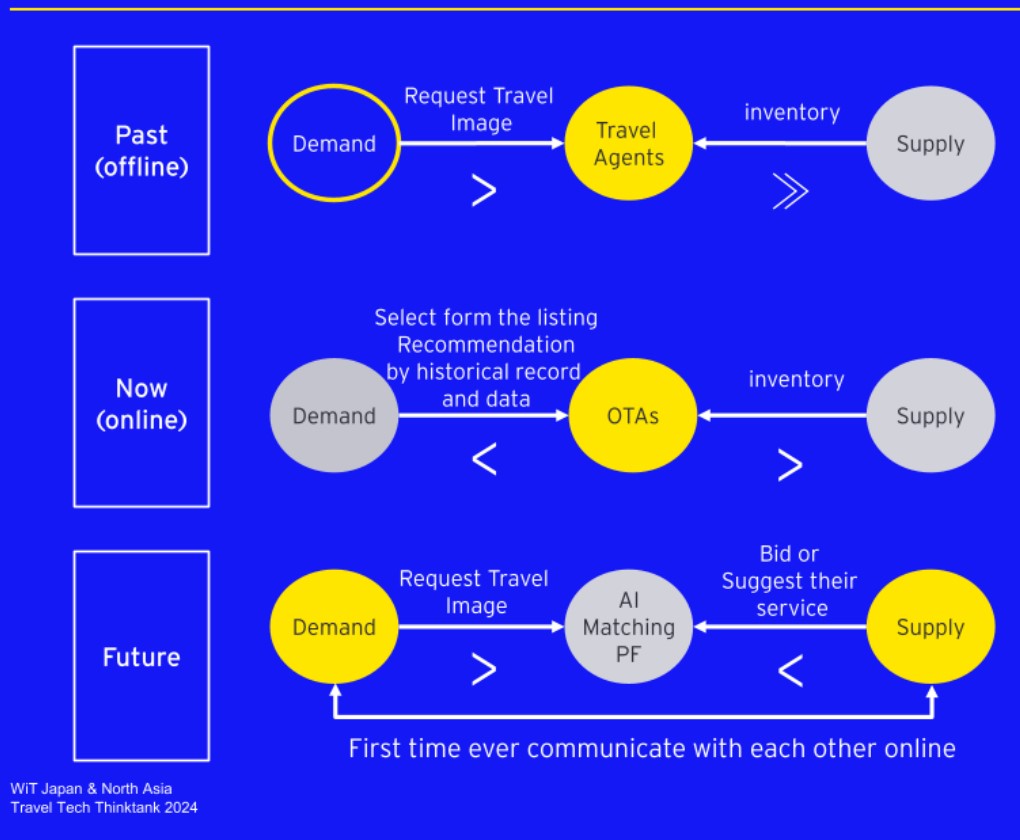The post DMO’s emerge as unlikely lynchpin to help suppliers win with AI appeared first on TD (Travel Daily Media) Travel Daily Media.
A recent Travel Tech Thinktank event organized by Web in Travel (WIT) in Japan has uncovered a huge opportunity for grass roots suppliers to leverage AI and fight back against a couple of decades of disintermediation caused by the rise of Online Travel Agents (OTA’s).
The presentation researched and presented by EY, via their Partner, Tomotaka Hirabayashi, laid out a future where hyper-personalization of requests by travelers will be best fulfilled only by the suppliers who know how to create the experience.
To date the transition over the past 3 decades or so has been from offline to online. Huge fragmentation of supply meant the opportunity was there to create the data sets that unify this supply and then make it bookable in a single spot. After 3 decades we have text-based listings, some photos and sometimes a map of where they are. Airlines and hotels went first. For tours, experiences and attractions, this has only occurred in the past decade. The price to pay for this has been high for the supplier, with commission rates pushing upwards of 30%. This has created more than just a love-hate relationship between OTA’s and suppliers but rather the feeling of being an indentured servant on the suppliers’ side.
The EY report then must come as a wonderful opportunity to upend this status quo, so how exactly might it work? In a copy of the presentation that Mr. Hirabayashi kindly shared with us at Everything AI in Travel, we see that “AI will facilitate supplier participation by visualizing and unbundling travelers’ needs and will further accelerate the shift to an industry structure that empowers suppliers.”
There are 3 things happening simultaneously here, all related to AI innovation. The first is that the traveler (and their own AI agent) will be able discern and communicate what it is they want better than any time in the past. We will move past just selecting things from lists as the mode of online. At the other end, AI will create room for much improved operational efficiencies, giving more time to craft the right experience, exactly for the customer. In the middle is the platform through which this communication will take place. In this structure, the OTA just slows things down. They don’t know what a supplier is capable of doing. They can only sell what is on the list. As such they quickly become antiquated in their offering.
The second part of the ThinkTank in Japan then workshopped some of this hypothesis, with one group working on “Empowering the Longtail with AI”. Their core finding was that the industry should seek to “develop standardized protocols for training Large Language Models so as to understand micro service providers needs and integrate them seamlessly with existing technology.”
That is easier said than done – especially in a competitive environment but let’s roll with it for now because this is where it got really interesting. The working group landed on Destination Marketing Organizations (DMOs) as being the lynchpin here. Specifically, the group suggested that DMOs should “reallocate funds from traditional ads to technology development”.
This may seem like a strange role for the DMO to play in the way we currently think of how most DMO’s operate, but in actually achieving their mission, it makes perfect sense. If we assume the role of the DMO is to assist all their tourism suppliers in finding markets equally and thereby creating sufficient economic impact for the country, then creating the conditions for the hypothesis above to be realized, is exactly what the DMO should be doing.
Actually, it helps the DMO also to make this switch also because no matter which DMO you are or what size you are, you always have 2 inevitable stakeholder questions you can just never avoid. The first, from your suppliers is “What have you done for me lately?” The second from all stakeholders is “What did you do with the money?” Taking this technology development approach in the right way can ensure the ability to answer both these questions definitively and by riding the AI wave through, which Tomotaka outlined as being a 35.5% CAGR through to 2030 opportunity, very likely ensures having some highly satisfying answers to both questions. This creates a huge opportunity for DMO’s to build a new standing inside the industry.
The working group also looked at the evolution of user interface and how that intersects with AI. Whilst this group who were mainly from North Asia zoomed in on the proliferation of chat platforms and their dominance in terms of consumer UI, in the West we might look at something like vertical video as being dominant.
To quote Mr. Hirabayashi from the report, “AI could bring back power to suppliers…and the structure of industry could change dramatically. The report goes on however with a warning “The quandary is whether suppliers are ready to seize the opportunity.” They almost certainly won’t be able to seize it alone, so the same question and quandary I suspect also goes to the DMO’s who have been identified as the organizations best situated to support it. Do DMO’s even want this role and responsibility? I’m sure some will relish it.
The post DMO’s emerge as unlikely lynchpin to help suppliers win with AI appeared first on Travel Daily Media.
